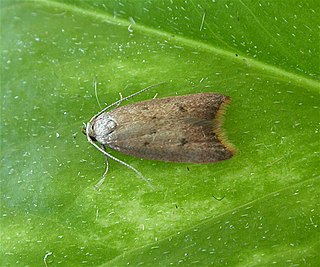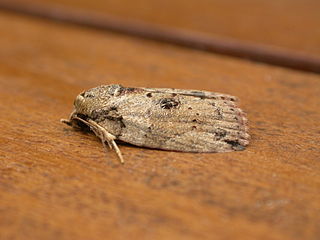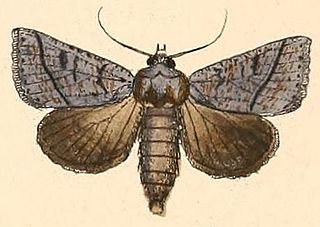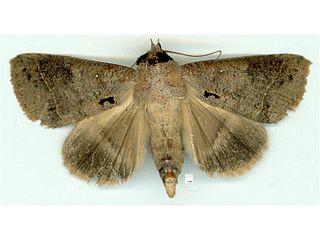Anomoses hylecoetes is a species of primitive hepialoid moth endemic to Queensland and New South Wales, Australia . It is the only species in its genus Anomoses, which is the only genus in the family Anomosetidae.

Nudaria is a genus of moths in the subfamily Arctiinae erected by Adrian Hardy Haworth in 1809.

Thysanoplusia orichalcea, the slender burnished brass, is a moth of the family Noctuidae. The species was first described by Johan Christian Fabricius in 1775. It is a polyphagous pest of vegetable crops that originated in Indonesia, from where it spread to Europe, South Asia, India, Sri Lanka, Africa, Australia and New Zealand. In northern Europe it is a migrant species.

Tachystola acroxantha is a moth of the family Oecophoridae. It is native to Australia, but is an invasive species in New Zealand and Europe, probably imported with Australian plants.

Pantydia sparsa is a moth of the family Erebidae. It is found in Queensland and on Norfolk Island. This species was introduced to New Zealand in 2004.
Heterorta is a monotypic moth genus of the family Noctuidae described by Warren in 1913. Its only species, Heterorta plutonis, was first described by Thomas Pennington Lucas in 1894. The species is known from Australia where it has been found in Queensland, New South Wales and Victoria.

Pantydia is a genus of moths in the family Erebidae.
Xenogenes is a genus of moths in the family Erebidae. The genus was erected by Edward Meyrick in 1910. Both species are found in Australia.

Nanaguna breviuscula, the pigeonpea pod borer, is a moth species of the family Nolidae. It is found from Sri Lanka and India east to Samoa. In Australia it is found in the Kimberleys in Western Australia, the northern part of the Northern Territory and from the Torres Strait Islands and Queensland to Sydney in New South Wales.
Schistophleps obducta is a moth in the subfamily Arctiinae. It was described by Thomas Pennington Lucas in 1894. It is found in the Australian states of Queensland and New South Wales.
Thallarcha macilenta is a moth in the subfamily Arctiinae. It was described by Thomas Pennington Lucas in 1894. It is found in Australia, where it has been recorded from New South Wales and Queensland.

Pantydia canescens is a species of moth of the family Erebidae. It is found in Australia, where it has been recorded from Victoria.
Pantydia diemeni, the gap-lined pantydia, is a species of moth of the family Erebidae. It is found in Australia, where it has been recorded from Tasmania, Queensland, New South Wales, the Australian Capital Territory, Victoria and Western Australia.

Pantydia metaspila is a species of moth of the family Erebidae first described by Francis Walker in 1858. It is found in China, Japan (Ryukyus), India (Maharashtra), Thailand, Taiwan, the Maledives, Sri Lanka, the Philippines, Borneo, Sumatra, Sulawesi, the Tanimbar Islands, Seram, Papua New Guinea, the Caroline Islands, the Solomon Islands, Vanuatu, Fiji, as well as Australia, where it has been recorded from Queensland.
Pantydia andersoni is a species of moth of the family Erebidae first described by Rudolf Felder and Alois Friedrich Rogenhofer in 1874. It is found in South Africa and Zambia.
Dichomeris holomela is a moth in the family Gelechiidae. It was described by Oswald Bertram Lower in 1897. It is found in Australia, where it has been recorded from New South Wales, Western Australia, the Northern Territory and Queensland.
Catoryctis mediolinea is a moth in the family Xyloryctidae. It was described by Thomas Pennington Lucas in 1894. It is found in Australia, where it has been recorded from New South Wales and Queensland.
Cryptophasa nubila is a moth in the family Xyloryctidae. It was described by Thomas Pennington Lucas in 1894. It is found in Australia, where it has been recorded from New South Wales and Queensland.
Paralecta tinctoria is a moth in the family Xyloryctidae. It was described by Thomas Pennington Lucas in 1894. It is found in Australia, where it has been recorded from Queensland.
Rylstone, an electoral district of the Legislative Assembly in the Australian state of New South Wales was created in 1894 and abolished in 1904.









